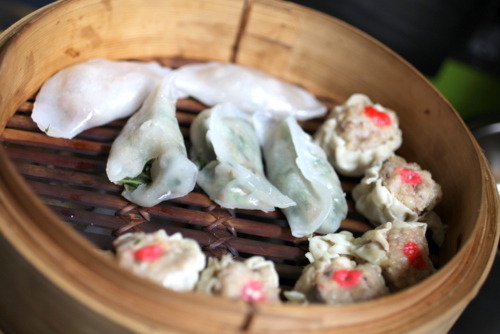A dozen or so shiny metal carts go strolling from table to table. Hungry guests wait in anticipation waiving their stamp cards in the air as if they’re hailing for a cab to see if their favorite dishes are found in the mountain high stacks of small steamer baskets. It sometimes gets competitive with a mad dash to get the food you want. Some people, including myself, sometimes treat it almost like a competitive sport. If you ever had it, you definitely know I’m talking about dim sum!
Not sure what it is? Some describe it as Chinese tapas and traditionally eaten during lunchtime with the accompaniment of tea. When you go out for dim sum, you “yum cha,” which directly translates to “drink tea.” Dim sum are small plates of Chinese food, such as dumplings, buns and various meaty concoctions.
Dim sum has emerged in popularity in the past years. It may still be foreign to some. If you have celiac disease, food you are unfamiliar with may sometimes be a challenge. The good thing is that many of the dumplings you see being pushed around in those carts use a rice-based wrapper, instead of wheat. The bad thing is that, like most Chinese cuisine, there is a probability of the food in question of containing soy sauce, particular salty foods.
For example, har gow is shrimp filling encased in a rice-based pleated wrapper. The wrapper if safe to eat, but the shrimp filling may contain traces of soy sauce. It varies from one restaurant to the next, so if you can’t establish clear communication with the servers or chefs then you may want to pass. But this and other similar looking dumplings can be okay to eat.
Congee is a safe bet. This is a delicious rice porridge and that is made with different foods added, from sea food, to bamboo shoots, to salted duck eggs. It’s traditionally made with white rice and cooked for several hours.
There are also different kinds of “cakes” you can try. It’s not exactly a fluffy cake you get on your birthday. Really, they don’t resemble any sort of traditional cakes. These are savory cakes, usually containing pork and dried shrimp. They’re flat and rectangular in shape and can be made with daikon or taro. For added flavor, it can be eaten with the spicy oil found on your table with the other condiments.
And no meal is complete without dessert. There are assortments of sweets you can try. Sesame rolls are one thing you’ll see common in most dim sum restaurants. They’re gelatinous, thin sheets of sesame rolled up. Mango pudding is…well, it’s pretty much what its sounds like. It’s topped with a sweet helping of evaporated milk.
Well, it may be a challenge to eat at a Chinese restaurant when you’re trying to avoid wheat and soy sauce, but there are definitely still plenty of options. Most dim sum restaurants will take special orders off the dinner menus. There’s a lot of rice and rice noodles-based dishes that are free of wheat. This is also the best time to let them to know to use salt in place of soy sauce, since these are likely made to order. Dim sum, specifically the dumplings, are usually made before hand and cooked or steamed before they’re carted out.
So while dim sum is still a mystery to some, definitely give it a try.
By Justin Chu


No comments:
Post a Comment